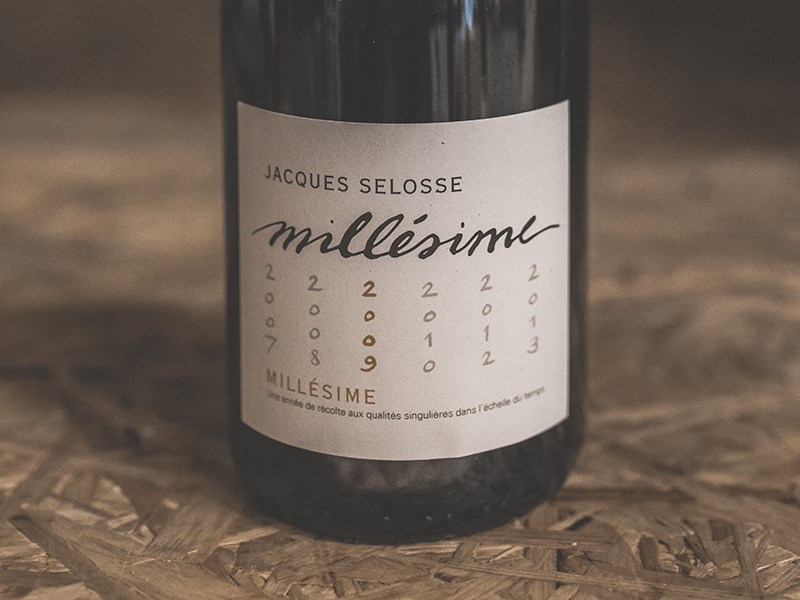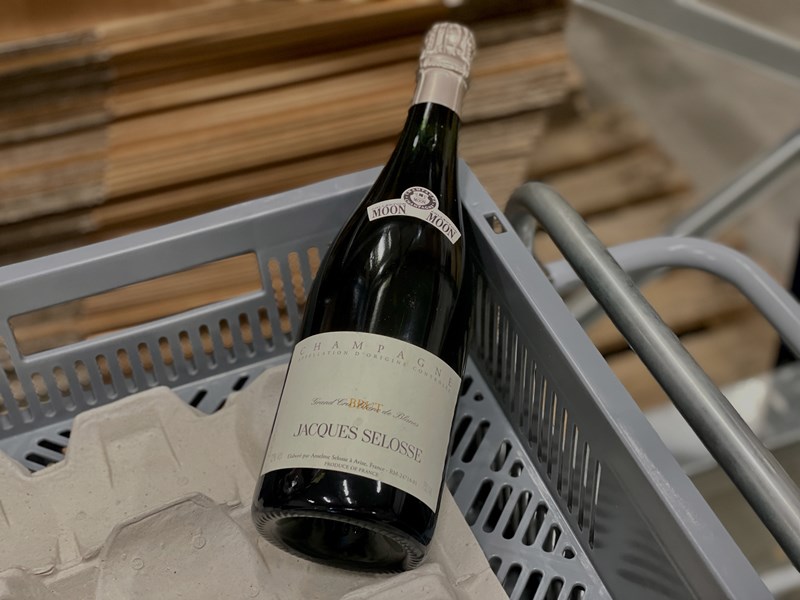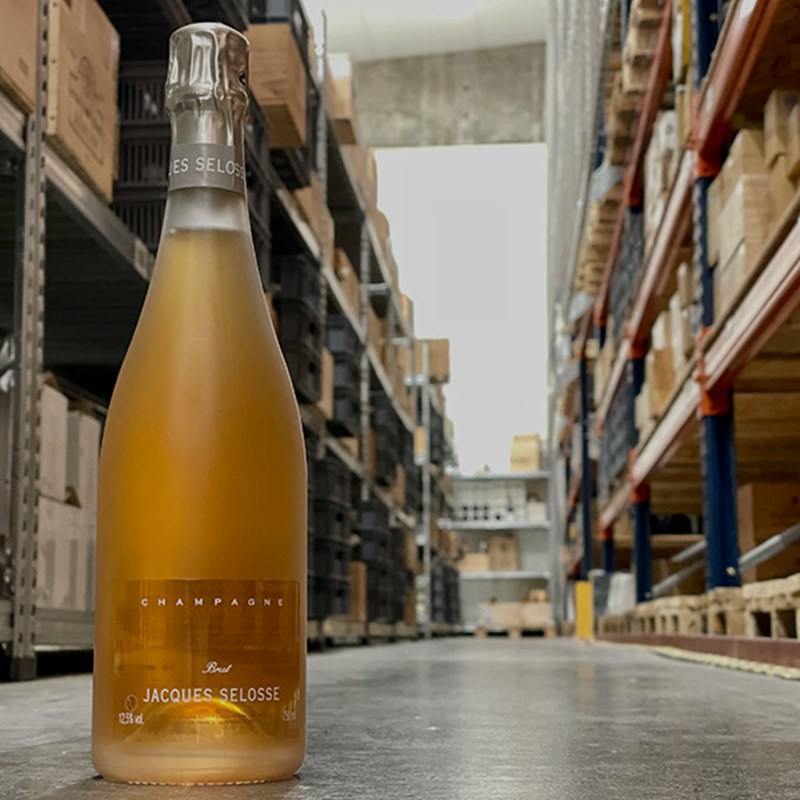Article - RareWine Academy
Jacques Selosse - The Icon Who Single-Handedly Revolutionized Champagne
Much of Champagne's high reputation is due to Anselme Selosse. He took over the Champagne house of Jacques Selosse and triumphed - because with him, Champagne was refined.
“The magic man from Avize has swiftly become Champagne's cult grower number one, after having been chosen as France's top winemaker in all categories by the magazine Gault Millau in 1994 […] Thanks for existing Anselme!” – Richard Juhlin
It is rare for an individual to be credited for an entire revolution, but that is the case with Anselme Selosse. He took over the Jacques Selosse Champagne House from his parents, turned it upside down and not only created internal magic - but changed the whole of Champagne for the better. He created the Grower Champagne phenomenon, which has since infiltrated the French stronghold of bubbly wines. Champagne Jacques Selosse is today one of the most coveted and refined Champagne houses, and although Anselme has deservedly stepped down, the success story seems to contain many more chapters...
Jacques Selosse: The Beginning
For centuries, the Selosse family has been growing grapes in Avize, but the first real step towards exceptional Champagne quality was taken when Jacques Selosse was the first in the family to start producing and selling his own Champagne in 1959. But even when Jacques Selosse decided to bottle his own wines, he still had his doubts - he still sold the vast majority of his harvest to Champagne Lanson, as it was associated with great security.
But when Jacques Selosse stepped onto shaky ground, doubts were quickly dispelled, and the wines of the house proved viable. By the time Anselme began his studies, Champagne Jacques Selosse was bottling his entire harvest for his own production, and the winners' podium was in its early stages of construction.
With Anselme Selosse, The Revolution Came Stealthily
Born into a Champagne family, Anselme was destined to continue in the bubbly footsteps of his ancestors. Indeed, many credit him for the much-needed revolution that came to Champagne in the 1980s, when Anselme entered the family business in earnest.
Anselme Selosse graduated in oenology in 1974 and returned to Champagne Jacques Selosse, where he was able to realize his vision. It would have been advantageous and obvious for Anselme to carry out his studies in Champagne, but he chose a different path that would determine his future success. He studied oenology in Burgundy, where he was introduced to Lafon, Coche-Dury and Leflaive, among others - and he brought the Burgundian traditions to Champagne.
In the 1970s in Champagne, there was a greater indifference to the quality of grapes and some of the big producers had the most say. What determined the price of the grapes was the town of origin, so small producers had little interest in pursuing time-consuming organic viticulture with much lower yields. But Anselme did not really care about that. His time in Burgundy had taught him one important lesson.

Grower Movement: Organic Farming And Drastically Reduced Yields
In 1980, Anselme formally took over Domaine Jacques Selosse from his father, and so began the great transformation. Among Burgundy's very best producers, there is now more or less a consensus that good wine requires healthy soils. Anselme also gained this insight while studying in Burgundy, and this lesson was crucial to his pioneering approach to Champagne making.
He was also blessed with some absolutely stunning Grand Cru parcels in Cramant, Avize and Oger, which certainly did not make his vision any less likely to succeed. The quality of the grapes now received Anselme's full attention, and with this came a greater focus on terroir, as it was (and is) the case in Burgundy. Labor intensive organic farming was practiced, resulting in greatly reduced yields, and this certainly did not please the traditionalists in Champagne, although others considered Anselme a revolutionary. The author of 'Champagne: The Essential Guide to the Wines, Producers, and Terroirs of the Iconic Region', Peter Liem has said:
“Whether directly or indirectly, he inspired an entire generation of young winegrowers in the region.”
Today, the Jacques Selosse Champagne House has 8.3 hectares spread over 54 parcels of high-profile vineyards in Cramant, Avize, Oger, Le Mesnil-sur-Oger, Ay, Mareuil-Sur-Aÿ and Ambonnay - producing between 50,000 and 60,000 bottles of Champagne per year.
When Anselme took the baton at Selosse, Grower Champagne was not a concept at all, but today it is considered one of the most exciting and interesting categories in the world and is gaining popularity day by day. The movement was strongly led by Anselme Selosse. The trademark of a Grower producer today is precisely a highly targeted focus on getting the best out of the individual, small parcels with a special focus on expressing terroir.
Wooden Barrels And Do-Nothing Farming
Anselme made radical changes in Champagne. And not only in the context of the organic transformation. He also started using yeast from his own vineyards for fermentation - a fermentation that takes place in oak barrels. Furthermore, he prevented the wines from undergoing their secondary malolactic fermentation. He minimized the addition of sulphur and started practicing battonage, which means stirring the sediment in the barrel to increase the complexity of the wine.
Furthermore, he also pioneered the addition of much less dossage, the mixture of reserve wine and sugar used to fill the bottle before it is sealed with its final cork stopper.
Anselme also chose the Jacques Selosse Champagne House to operate according to biodynamic principles, which they decided to discontinue in 2003. Instead, over the past 20 years, the family has developed its own system of viticulture that is not dictated by any specific method. Anselme and his son, Guillaume, have often explained their role as gatherers - gatherers who go out into nature and harvest the fruits found there.
According to Anselme, the inspiration came from Masanobu Fukooka - a Japanese farmer and philosopher. He operated according to a so-called 'do-nothing farming' principle, where observation of the principles of nature is essential. Humans disturb nature the most, and therefore should refrain from interfering. Selosse adapts to the circumstances that arise in the different vineyards from year to year and does as little as possible.
Elimination Of Vintage...
Anselme is a pragmatist, and it is clear that he is not dictated by ideological principles or outdated rules for the production of Champagne. It was not enough for him to simply refine the same old Champagne melody. He wanted to do something completely new. This really came to life when he started comparing Champagne to Burgundy. Because, according to Anselme, there is a big difference between the prestige of a wine in the two French wine strongholds.
In Champagne, the prestige of a wine is determined by the vintage in which it is born. This is not the case in Burgundy, where prestige is often linked to physical origin - i.e., the vineyard and terroir. Therefore, it became important for Anselme to emphasize terroir in his wines and thus create a sense of location in the final Champagne. And so Selosse sought to eliminate the vintage altogether, but he needed a method.

Solera Planted The Seeds For Substance
Terroir was more important than vintage, but Anselme was still missing an important piece to erase the vintage completely. In 1972, he traveled to Spain and visited a number of producers in Jerez. It was here that the very first seeds of what would later become the house darling substance were planted. As a direct result of his visit to Jerez, Anselme decided in the mid-1980s to adopt the Solera method, which was being used to produce Sherry (Jerez). Now the result would simply be Champagne with the vintage eliminated.
Solera is a method in which part of the wine is a blend of older vintages. The average age of the wine thus gradually increases year by year. A small amount from each barrel is bottled each year and topped up with younger wine that adds freshness to the older wine. It is thus a blending and ageing technique consisting of several layers of barrels, with the bottom barrel becoming the source of the final blend. Each time the lower barrel is tapped, the wines in the upper barrels are used to top up again. The final blend is thus fractionated and consists of wines from many different vintages.
In Champagne, the method is described as a perpetual reserve, where a base vintage is blended with reserve wines from previous vintages, and Selosse's lieu-dit Champagnes are made in exactly this way, with blending taking place just before bottling. However, the house's Substance Champagne is a little different.
Substance - The Selosse Darling
There is no doubt that Substance is the most hyped release from Jacques Selosse. It was originally named Origine, but because Selosse did not have a copyright on the name, he was forced to change it in 1998, and so the name became Substance instead. Around 3,000 bottles a year are produced and there is massive demand.
For Substance, Selosse uses a true Solera method with two levels of reserve wines - so-called criaderas. One wine is aged in barrel and the other in tank. The youngest vintage in Substance accounts for around 22% and is aged with the reserve wine. It then spends 6 years in bottle before being disgorged. The date and year of bottling are on the back of all releases.
Anselme has said that Substance includes all vintages: Good, bad, mediocre. Hot, cold, and perfectly normal. And that all these differences are, in theory, equalised in the blend.
”Substance has been called a Montrachet with bubbles and everywhere the wine receives figuratively standing ovations when judged” – Richard Juhlin
There is absolutely no doubt that Anselme has succeeded in making Selosse's Champagnes some of the most sought-after in the world. And at the top of this limited, quality-heavy Champagne mountain, Substance stands supreme. The mere 3,000 bottles produced annually barely make it out of the house before disappearing into the vast crowd of wine lovers who have fallen under the spell of Substance.
Guillaume Selosse: An Almost Symbiotic Domain Takeover
All things come to an end, and in 2018 Anselme decided to retire after almost 40 years at the helm of Jacques Selosse. Guillaume Selosse is Anselme's son, and it is he who now operates the domain. And the news of Anselme's abdication was received by the wine world with a surprising calm, which must be due to the fact that Guillaume Sellosse had already earned a reputation as another Selosse genius at the time of the domain succession.
Anselme and Guillaume have worked closely together for years - Guillaume grew up among the vines of his ancestors and the bubbling perfection flows in his veins - with imagination and extraordinary abilities that are fully in harmony with the Selosse way.
A Fabulous Foretaste For The Few
One might be led to believe that the wine world will only really see Guillaume's talent when Selosse releases their 2018 Champagnes, which have been under the sole responsibility of the heir apparent. But Guillaume has not earned his reputation by building castles in the air.
In 2009, Guillaume received a number of old vines in Cramant as an 18th birthday present from his grandmother, and Guillaume started making his own wine. The name of the wine is Au Dessus du Gros Mont, and the releases were a success from the start:
“Guillaume has been given his own responsibility for this fantastic vineyard in Cramant. With 600 bottles from 3 barrels, he has followed in his father's footsteps and created magic with exactly the same style in this version […] rich medium taste and resiliently elegant finale that leads to heaven.” – Richard Juhlin
In addition to Au Dessus du Gros Mont, Guillaumes has also made another cuvée called Largillier. It is made from fruit bought from Jérôme Coessens in Aube. Each time Guillaume bottles the wine from the tank, he leaves 300 litres behind to serve as a reserve wine for the next edition. Largillier is produced in Anselme Selosse's old cellar in Avize, and only around 650 bottles are produced per vintage. Largillier represents a very different expression from Au Dessus du Gros Mont, which is closer to the usual Selosse style - and it just goes to show that Guillaume is both consistent in quality, but also dares to challenge his own talent.
And it is precisely because of these two rare wines that Guillaume has earned his reputation - and that is why the world's wine lovers and wine critics are confident that the Champagne House of Jacques Selosse will continue to be in the very best hands.

The Champagnes Of Jacques Selosse
Substance reigns as the absolute crown jewel at Jacques Selosse, but there is of course plenty of quality to be found - regardless of the name of the house's releases. In addition to Substance, the house also makes wines with the names: Initial, Version Originale, Millésimé and Rosé.
Selosse – Initial
Initial has a reputation as one of the best base wines in the world. It is a Blanc de Blancs made from the wines of three consecutive vintages and is typically released five years after the last vintage to appear in the blend. The grapes come from the lower lying soils of Oger, Avize and Cramant. The wine matures for three years before being disgorged and the date of disgorgement is always indicated on the back of the bottle. Around 30,000 bottles of Initial are produced each year and a loyal fan base waits hopefully each year for a share of this release.
Selosse - Version Originale
Selosse has also created Initial's counterpart, Version Originale, which is also made from three consecutive vintages. The difference between the two, however, is that the grapes for Version Originale come from the higher, more calcareous parts of Avize, Oger and Cramant, where annual yields are only about a third of Initial's - perhaps even lower, as only the very best grapes from the vineyards are used. The wine is aged for a minimum of 42 months and released 6 years after the last vintage in the blend.
Selosse - Millésimé
Although Anselme Selosse tries to eliminate the vintages in his wines through Solera systems, there is one wine that has for years reflected the character of the single vintage. Millésimé was originally a Blanc de Blancs made from grapes from two small parcels in Avize that were so similar that it allowed for the study of the influence of the vintage on the single vintage wine. In 2007, however, Anselme decided to change the procedure so that Millésimé can now include wines from any parcel deemed worthy. Only around 4,000 bottles of Millésimé are produced per vintage.
Selosse - Champagne Brut Rosé
”What can I say about Jacques Selosse’s NV Rosé? That it was superb? Phenomenal? Sublime? It was all that and so much more” – Antonio Galloni, Vinous
Like most great Champagne houses, Jacques Selosse also has a Champagne Rosé, and like the rest of the house's wines, this one continually knocks the critics off their feet - almost no matter which release is being judged. It is a wine based on grapes from two consecutive vintages, and the grapes come exclusively from Chardonnay in Avize and Pinot Noir from Ambonnay. It is typically released five years after the last vintage of the blend and only around 6,000 bottles are released per vintage.
Another highly limited wine from the Jacques Selosse selection. Highly limited and highly sought after.
Selosse - Collection Lieux-dits
In addition to its already highly sought-after and limited releases listed above, Champagne Jacques Selosse also presents a collection of single vineyard wines in a single case called Collection Lieux-Dits. The case consists of six releases representing six different areas of Champagne and is intended as an opportunity to taste different terroirs from the same vintage.
The grapes used in the wines all come from the same vintage, meaning that one release, for example, is made from 2003 grapes in one release and 2004 grapes in the next. The six wines are called:
- La Côte Faron (Ay)
- Les Carelles (Mesnil-sur-Oger)
- Le Bout du Clos (Ambonnay)
- Sous le Mont (Mareuil sur Aÿ)
- Les Chantereines (Avize)
- Chemin de Châlons (Cramant)
The top four wines can also be bought in individual bottles, whereas the last two wines, Les Chantereines and Chemin de Châlons are only produced and sold as part of the collection because they are both highly limited. Only around 300 Lieux-dits cases are released per year, so this exclusive wine experience is only available to a small number of Champagne lovers.
Where Are Guillaume And Jacques Selosse Heading?
There is no doubt that many of the world's wine lovers wish Selosse could solidify in its current form. Fortunately, there is nothing to suggest that Guillaume intends to revolutionise his Champagne house as radically as his father did. The father-son symbiosis has created the perfect transition to a new chapter for Champagne Jacques Selosse - a chapter that preserves quality, protects nature, and prioritises quality over quantity.
Guillaume carries Selosse forward, and while the status quo sounds appealing, Guillaume is not going to sit back.
